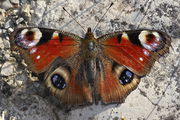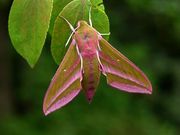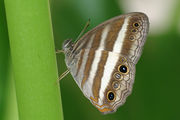Lepidoptera
| Lepidoptera |
|---|

|
| Scientific Classification |
|
| Families |
|
| A humming bird moth hovering over a pink flower |
Lepidoptera is a taxonomic order of insects that includes both the moths and butterflies. They are best known as the beauties of Class Insecta - one of God's most beautiful creations. They are marvelous in the way that they look, communicate, and reproduce. Their metamorphosis from a pupa is one of the most memorable characteristics of Order Lepidoptera, and sets them apart from other insects.[2]
The subjects of body design, life cycle, ecology, and the comparison of moths and butterflies are only a few categories that can describe the complexity of their way of life. Their body design is a dynamic topic that takes the moth of butterfly and discovers the complexity and make up of the organism. They have two pairs of wings that are covered with scales. Butterflies have a vast variety of colorful wings, while moths have duller colors. God has given the world beauty that declares his glory. God is very present in nature and it is very evident through the moth and butterfly.[3]
Body Design
Order Lepidoptera's body design is extremely unique and outstanding. With their delicate wings and striking colors, moths and butterflies stand out as the main beauty of Class Insecta. The way that their bodies are designed is a godly and amazing thing. Their bodies are designed for flight and also pollination. The body structures of moths and butterflies are similar, but moths have a furrier, rounder body and antennae with smaller wings. Despite these factors, moths and butterflies look fairly similar.
Adult moths and butterflies have four grand membranous wings. Each wing is covered with scales that overlap each other. The overlapping of the scales is what instigates the intense vibrant colors of the moths and butterflies. The color is caused by the tops of the scales shattering the light hitting them. Another way that color is shown is by the pigments in the wings of the insect. The wings of moths and butterflies are used for protection and instillation. In order to defend themselves from predators, the insect will use its wings for camouflage and confusion. A moth or butterfly will camouflage itself in order to hide and to prevent themselves from being eaten. Each species from the Order Lepidoptera has a different and unique color. Some moths and butterflies confuse their predator with mimicry. The color and body shape of the insect will often times resemble a harmful species in order to trick the predator into thinking that its dangerous or poisonous. By a mere glance, the insects look the same, but in reality they are two different species. These tactics ensure the survival of the species.[4]
The head of the moth and butterfly is a round shape that holds its antennae, eyes, palpi, and proboscis. The antennae extend from the space between the insects eyes. They can be used for navigation and pheromone detection. Antennae are used to communicate physically much like the behavior of bees and ants. They assist in sexual mating by being able to detect males. Moths and butterflies have round and spherical compound eyes that hold thousands of light receptors, creating a mosaic image around the insect. Butterflies and moths are unable to blink, so in order to protect their eyes, the insect has a labial palpi that filters dust out of the compound eye. Labial palpi are projections that are covered with olfactory sensors. They are located on the antenna, thorax, abdomen, and legs. These senors are able to detect food. The proboscis of the moths and butterflies work as a tongue like straw that sucks up nectar into the mouth of the insect. It assists the insect with reaching into deep flowers so that it can feed and pollinate. Moths and butterflies have a long body called the thorax that is located in the middle of the membranous wings. It consists of three body segments. The wings, head , legs, and abdomen are attached to this muscular body part. The thorax controls the wings and how fast they beat. The three pairs of legs of an insect provide support as well as sensory abilities. The legs give the moth and butterfly a soft landing after flying and minimal movement on the ground. The abdomen contains the reproductive and major organs of the Order Lepidoptera. Moths and butterflies reproduce sexually. They use spiracles for respiration, which cause air to be drawn into the into small lung sacs.[5]
Life Cycle
The life cycle of the order Lepidoptera is complex yet beautifully designed. Moths and butterflies transition through a four-stage life cycle that is known as complete metamorphosis. In order for the metamorphosis to be successful the moths and butterflies must go through four-stages in order to reach it's adult form. The stages consist of the egg, larva, pupa, and adult. The moth and butterfly are insects that need to have a uninterrupted metamorphosis in order to fulfill its adult form.
The first stage is the egg. Once the mother has successfully mated, the butterfly or moth will lay her eggs in a place that will provide an adequate food supply for her young. The mother will usually lay her eggs on plants for food and protection. The next stage is the larval stage. The eggs will hatch after their development has completed. Moth and butterfly larvae are known as caterpillars. Once the larvae hatches, it will begin to feed and take in nutrients from its shell and from the plant it has been laid on. The caterpillar will continue to eat and molt until it forms its pupal skin and prepare to transition the next stage. [6]
The pupal stage is where the most transformation takes place. The insect remains motionless for a period of time. During this time it will not eat or move. The butterflies form a chrysalis and moths form cocoons. Inside the insect's pupal case the caterpillar's body almost completely breaks down. Special groups of cells called histoblasts, begin to transform the broken down caterpillar into a moth or butterfly. When the metamorphosis is complete, the moth and butterfly will abide in it's case until it is triggered to emerge from its chrysalis or cocoon. Once the adult breaks through its case, it will endure a swollen abdomen and shriveled up wings until it is able to pump blood through its wings.[7]
Ecology
Moths and butterflies live and survive in diverse habitats around the world. They can live and breed in places from grasslands to swampy marshes. The insects habitat must include a safe and secure place to complete its stages of life (egg, larva, pupa, and adult). Since moths and butterflies survive in many different habitats, the number of species depends on the seasons and native species living there. Some areas may have over 400 different species living a specific habitat. Moths and butterflies begin to appear during late spring to early winter, depending on the species. They are most abundant during warm summers. [8]
Moths and butterflies feed on nectar from a variety of plants and flowers. Since the adult has a proboscis for feeding, the food must be a liquid. Nectar is a sugary substance that provides the butterfly with enough fuel to fly and reproduce. The larval stage of the insect, or the caterpillar, feed on the leaves of the plants where they were laid. At this point the caterpillar must ingest as much food as it can in order to have enough strength to become a adult.[9]
There are many predators of Order Lepidoptera. Since they are such easy targets because of their bright colors, God has designed them to use different defenses and camouflages to stay alive. Birds are one of the main predators of moths and butterflies. Birds rely on vision to spot and catch prey. Spiders, wasps, dragonflies, and crickets are insects that feed on moths and butterflies. Spiders capture their prey primarily in webs, and since moths and butterflies use their wings to travel, they will end up falling victim to the spider. Caterpillars are flightless, so as a result their list of predator are greater. Their main predators include snakes, beetles, spiders, rodents, and toads. A moth or butterfly is able to lay up to 500 eggs, but usually only 100 will be laid. On average 80 percent of those caterpillars will eaten by a predator.[10]
Moths vs. Butterflies
Moths and butterflies are similar in appearance, and are often confused with each other. They are two different insects even though they thrive in the same Order. The moth is duller in color and often consists of brown tones in their wings. The moth has a fatter and hairier body structure, while the butterfly has a long slender body. The antennae of the moth are short and feathery, which is a distinguishing quality of the moth. The butterfly's antennae are long, thin and swell out at the end. In the regards hearing, moths have functional ears, while butterflies cannot detect sound. Moths use scent to attract mates, while butterflies use sight. Since butterflies have no sense of hearing, it is logical that they use sight for the attraction of mates. Butterflies and moths both fly, but butterflies do so during the day, while moths fly during the night.[11]
Gallery
Butterflies
Moths
rice paper butterfly
(Idea leuconoe)
Family: NymphalidaeEuropean Peacock
(Aglais io)
Family: NymphalidaeElephant Hawk-moth
(Deilephila elpenor)
Family: SphingidaeTwo-banded Satyr
(Pareuptychia ocirrhoe)
Family: Nymphalidae
References
- ↑ VanDyk, John. Order Lepidoptera-Butterflies and Moths. “BugGuide”. Web. 12-14-14.
- ↑ Cashatt, Everett. Online Collection of Butterflies and Moths. “Illinois State Museum Butterflies and Moths Collection”. Web. January-11-2015.
- ↑ Cashatt, Everett. Introduction of Butterflies and Moths. “Illinois State Museum Butterflies and Moths Collection”. Web. January-11-2015.
- ↑ Unknown, Walter. Lepidopetra. “ Walter’s Insectidentification.net”. Web. 12-14-14.
- ↑ Hoskins, Adrian. 2.htm Butterfly Anatomy. “learn about Butterflies the complete guide to the world of butterflies and moths.”. Web. 12-14-14.
- ↑ Culin, Joseph. Lepidopteran. “Encyclopaedia Britannica”. Web. 12-14-14.
- ↑ Hadley, Debbie. Life Cycle of Butterflies and Moths. “About Education”. Web. 12-11-14.
- ↑ Brian, Patrick. [ http://www.teara.govt.nz/en/butterflies-and-moths/page-3 Story: Butterflies and moths]. “Teara The Encyclopedia of New Zealand”. Web. January-4-2015.
- ↑ Hoskins, Adrian. Ecology. “learn about Butterflies the complete guide to the world of butterflies and moths”. Web. January- 4-2015.
- ↑ Hoskins, Adrian. of Butterflies.htm The Enemies of Butterflies. “learn about Butterflies the complete guide to the world of butterflies and moths”. Web. January- 4-2015.
- ↑ Sehgal, Pooja. Butterflies vs. Moths. “Diffen”. Web. January- 11- 2015.









